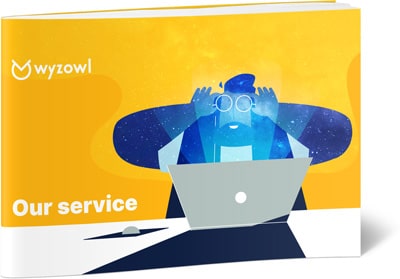Training employees is important for many reasons, playing a key role in staff satisfaction, engagement, productivity and retention.
But how? Why? And how do you go about doing it?
The silver bullet could well be video. It helps you capture your employees’ attention with interesting visuals and engaging storylines. Not only that, you can break down complicated information in an easy-to-digest way.
Let’s dig deeper and find out more…
Why use video for training?
The most commonly used training method across businesses, used exclusively or mostly (90-100% of the time) by 13% of organisations, is classroom training. And it is probably so popular because it mimics the traditional learning format we are used to from school and college. But in business, it is not as effective as should be for many reasons.
For a start, hiring a classroom trainer is expensive.
The only way to make it worth the money is to squeeze as many employees into the class as you can, but then of course each employee gets less attention and help when they need it.
There is also the problem of pacing. Nobody learns at the same pace, and in a classroom environment this can make some people feel unchallenged and ready for more, while others are struggling to keep up.
Then there are other methods of training, such as ‘on-the-job’ or an e-learning platform, but these are difficult to monitor and can leave you knowing little about how effective the training was.
With video, you can eradicate these problems.
Using video as a replacement for classroom training (and other forms of training) has been proven to increase productivity and reduce costs!
Here’s how to train employees using video, with five different use cases…
1. Onboarding
The first day at a new job is rough.
It’s a day filled with sweaty handshakes, forgetting people’s names, and reading boring documents.
By using video as an onboarding tool, you can help your employees get off to a good start from day one.
And getting off to a good start really does make all the difference.
A solid onboarding program can play a huge part in making sure employees integrate into the team well and start adding immediate value.
In addition to being an engaging way to absorb information, onboarding videos also ensure that all new starters have the same experience.
With something like classroom training, for example, there are so many varying factors: the teacher, the time of day, the amount of people in the room.
But with a video, all you need to do is hit play. Then afterwards, employees can refer back to the video as many times as they need to in order to fully digest the information – allowing them to learn at their own pace!
There are a couple of different types of onboarding videos you can make, ranging all the way from an informal “Welcome to the team video” to a breakdown of the company culture and what the new employee can expect on a day-to-day basis.
Here’s an example of a welcome video:
Short and sweet – that’s all you need. This is a great way for new employees to learn more about their colleagues, the culture, and the personality of your brand.
Here’s an example of a more comprehensive onboarding video:
This video goes into depth about the goals of the business and what is expected from employees.
Both of these videos can be used in conjunction with each other – and any other types of videos specific to your business or the role you’re hiring for – to create a full onboarding process.
A great onboarding video can also help with employee retention.
According to one study, companies with a formal onboarding process have an average employee retention rate of 86%. This is 30% more than those without! It’s clear how important it is to put a lot of effort into retaining your new investment, aka your new starter.
2. Product or service breakdown
It goes without saying that it is very important for your staff to know your product(s) or service(s) inside-out. This is knowledge that they should be equipped with from the very start, and if anything changes about your products or the services you offer, then employees need to be updated about this too, especially if they are directly selling to customers.
Product and service breakdown videos are helpful for teaching your employees exactly how to use them, but they are also extremely useful for sales teams. In order to sell your product and/or service, your sales staff need to completely understand how it works, how it can solve the problems of your customers, and how it can benefit them. With a quick product or service breakdown video for them to refer to, they can refresh their memory as often as they need to.
3. Interactive
Interactive video is still the new kid on the block. To give you a quick overview, interactive videos are videos that viewers can interact with, meaning people can click on items within the video to determine what happens next. This gives people their own experience within the video and takes them to the content they want to see rather than showing them everything in a linear way. With attention spans shrinking all the time, tailored interactive content is a great way to keep your employees’ attention!
Interactive videos are also great for tailoring your training to different departments and job roles. Instead of asking everyone to watch an entire overview of your business, different employees can click on different parts of the video that apply to their role.
For example, if you create explainer videos (like Wyzowl!) you could create an interactive training video for your employees that shows the full process of creating a video, but the writers can watch the part that is relevant to them, and the animators can watch the part this is relevant to their job role.
In addition to that, interactive videos also offer you clear results that show you who clicked what so you know who needs a little more training, and who is ready to go.
Here’s an example of an interactive training video for hair stylists:

This video allows viewers to learn at their own pace and choose their own path, so they only view the topics that they need to do their job correctly. It’s a great way to make the entire training process more streamlined and more engaging for employees.
4. Management coaching
Moving into a new job role is exciting, but it can also be intimidating if you don’t know what is expected of you. And if you want your company to be as productive as possible, you need good management. According to a recent study, the average organisation is 50% as productive as it should be, thanks to less-than-optimal leadership practices.
Take a look at this simple whiteboard video that teaches managers how to delegate:
This shows that you don’t need to invest too much to make an effective training video. Tools like this are amazing for management coaching not only because they are inexpensive, but because, as we’ve already said, they can be referred to numerous times as and when they are needed.
Videos are great at breaking down complicated information into easily digestible chunks. Engaging graphics paired with a voiceover or text-on-screen can help employees to remember and retain new information. A study from the SAVO Group found that when you pair relevant visuals with learning information (e.g. make a video!), retention levels rise to an impressive 65%!
5. General training
So far, our examples of how to train employees using video have been very specific, but the truth is, you can use video for any training purposes ! Whether you’ve got a new system to train people on, are changing your business direction, or you just want to recap best practices, video can help you.
Take a look at this video by Nikwax:
This video teaches employees how to sell aftercare to clients in order to improve their customer service. They keep the messaging quite general so that it can appeal to all retailers who sell Nikwax, but at the same time, they also give salespeople very specific suggestions of what they can say to customers.
Training videos like this eliminate the need to travel to different branches, reduce costs, and give you better insights into your employees’ learning styles. It’s reasons like this, and all of the above we have mentioned, that make video one of the most effective tools for training your team.
Closing thoughts
There are many different options available to train your employees: classroom training, reading materials, on-the-job training, and more! But none of them are as simple, engaging, and as cost-effective as video. Videos are easy to make and fun to watch, making them a win-win as a training resource! There are many situations that videos can be used for, and there are a lot of benefits that we have only just started to touch upon here. For more useful information about training videos, including case studies and examples, check out our online guide How to Use Video to Train Your Team.







